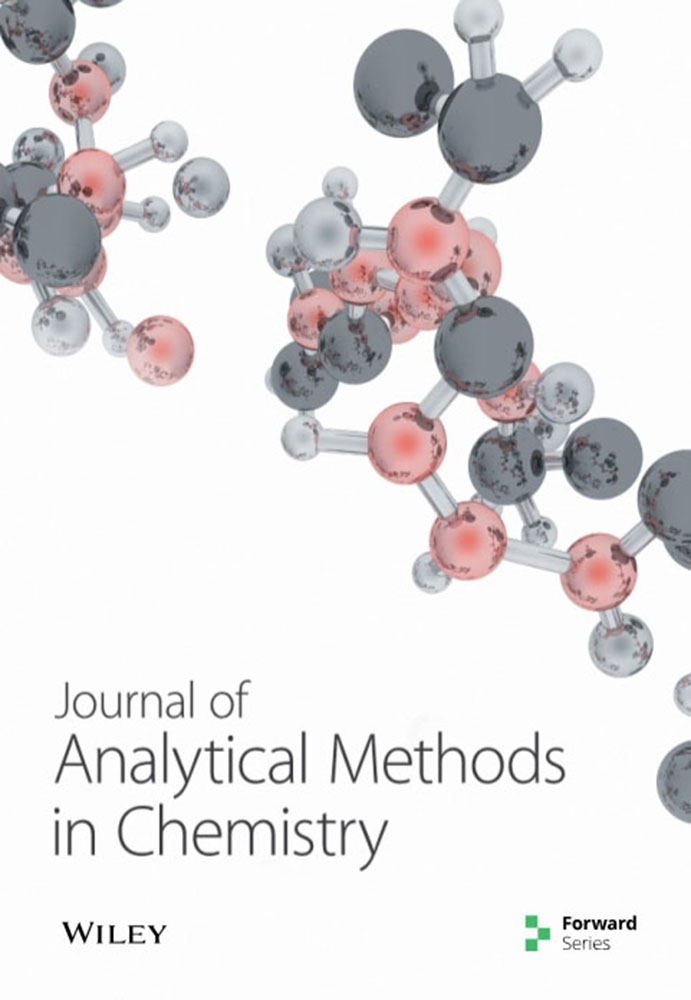自制无膜汽化气液分离器比色法测定酒精饮料中乙醇
IF 2.3
3区 化学
Q3 CHEMISTRY, ANALYTICAL
引用次数: 0
摘要
这项工作利用了所谓的无膜汽化(mll - vp)装置作为气体分离器的简单性,用于酒精饮料中乙醇的比色测定。将体积为1ml的饮料样品直接注射到一个小容器中,该小容器挂在一个封闭的40ml重复使用玻璃瓶的盖子上,不进行蒸馏等预处理。酸化的重铬酸钾(Cr2O72−)受体溶液,预先加入到玻璃瓶中,通过从样品中蒸发的乙醇的扩散还原为铬(III)离子。5 min后,收集吸收液在590nm处进行比色检测。该装置手动定量1.0-90% (v/v)范围内的乙醇,日间精密度令人满意,但没有基质效应(回收率89 - 109%)。用常规蒸馏/浓度计法对12种酒精饮料的乙醇含量进行了验证,结果表明两种方法的乙醇含量与申报值无显著差异,具有足够的准确性。使用这种方法对酒精饮料进行分析是成功的,其优点是简单、便宜、耗能少。本文章由计算机程序翻译,如有差异,请以英文原文为准。
Home-Made Membraneless Vaporization Gas-Liquid Separator for Colorimetric Determination of Ethanol in Alcoholic Beverages
This work utilized the simplicity of a so-called membraneless vaporization (MBL-VP) unit as a gas separator for the colorimetric determination of ethanol in alcoholic beverages. A beverage sample with a volume of 1 mL was directly injected into a small container which was hung from a lid inside a closed 40 mL reused glass bottle without pretreatment such as distillation. An acidified potassium dichromate (Cr2O72−) acceptor solution, preadded to the glass bottle, was reduced to Chromium (III) ion by the diffusion of vaporized ethanol from the sample. After 5 min, the absorbing solution was collected for colorimetric detection at 590 nm. The unit manually quantifies ethanol in the range 1.0–90% (v/v) with satisfactory interday precision but without matrix effect (recovery 89−109%). The method was validated with the conventional distillation/pycnometer method which showed no significant difference of ethanol contents between those two methods and the declared values of 12 alcoholic beverages, indicating sufficient accuracy. Analyses of alcoholic beverages using this method were successful with benefits of simplicity, cheapness, and less energy consumption.
求助全文
通过发布文献求助,成功后即可免费获取论文全文。
去求助
来源期刊

Journal of Analytical Methods in Chemistry
CHEMISTRY, ANALYTICAL-ENGINEERING, CIVIL
CiteScore
4.80
自引率
3.80%
发文量
79
审稿时长
6-12 weeks
期刊介绍:
Journal of Analytical Methods in Chemistry publishes papers reporting methods and instrumentation for chemical analysis, and their application to real-world problems. Articles may be either practical or theoretical.
Subject areas include (but are by no means limited to):
Separation
Spectroscopy
Mass spectrometry
Chromatography
Analytical Sample Preparation
Electrochemical analysis
Hyphenated techniques
Data processing
As well as original research, Journal of Analytical Methods in Chemistry also publishes focused review articles that examine the state of the art, identify emerging trends, and suggest future directions for developing fields.
 求助内容:
求助内容: 应助结果提醒方式:
应助结果提醒方式:


